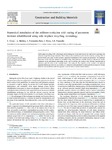Numerical Simulation of the Stiffness Evolution With Curing of Pavement Sections Rehabilitated Using Cold In-Place Recycling Technology

Use este enlace para citar
http://hdl.handle.net/2183/30485
A non ser que se indique outra cousa, a licenza do ítem descríbese como Atribución-NoComercial-SinDerivadas 4.0 Internacional (CC BY-NC-ND 4.0)
Coleccións
- Investigación (ETSECCP) [826]
Metadatos
Mostrar o rexistro completo do ítemTítulo
Numerical Simulation of the Stiffness Evolution With Curing of Pavement Sections Rehabilitated Using Cold In-Place Recycling TechnologyAutor(es)
Data
2022Cita bibliográfica
P. Orosa, L. Medina, J. Fernández-Ruiz, I. Pérez, A.R. Pasandín. (2022). Numerical simulation of the stiffness evolution with curing of pavement sections rehabilitated using cold in-place recycling technology. Construction and Building Materials, v.335, 127487. https://doi.org/10.1016/j.conbuildmat.2022.127487
Resumo
[Abstract] Cold in-place recycling (CIR) technologies are becoming one of the main bets in the road sector to promote the reduction of greenhouse gas emissions. This technique also contributes to the circular economy, reusing 100% of the RAP from worn roads. In this research, numerical simulations of CIR sections are presented. The nonlinear behaviour of the CIR-base material is modelled using three predictive models based on triaxial test results. Variations in the performance depending on the type of subbase, the curing of the CIR-base material and its thickness, and the effect of the wearing-course were analysed. The response of the sections with unbound granular subbase proved to be very sensitive to variations in the parameters studied, and the increase in CIR base thickness was beneficial, while the opposite occurred with a cement-treated subbase.
Palabras chave
3D numerical model
Cold in-place recycling (CIR)
Bitumen stabilised material (BSM)
Reclaimed asphalt pavement (RAP)
Bitumen emulsion
Triaxial testing
Nonlinear elastic behaviour
Rutting
Cold in-place recycling (CIR)
Bitumen stabilised material (BSM)
Reclaimed asphalt pavement (RAP)
Bitumen emulsion
Triaxial testing
Nonlinear elastic behaviour
Rutting
Descrición
Financiado para publicación en acceso aberto: Universidade da Coruña/CISUG
Versión do editor
Dereitos
Atribución-NoComercial-SinDerivadas 4.0 Internacional (CC BY-NC-ND 4.0)






